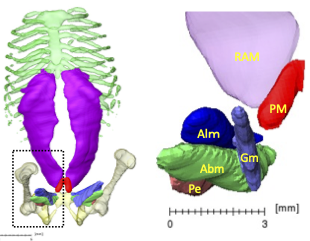岩佐さんの錐体筋の形成についての論文がCongenit Anomに受諾されました。雑誌の表紙に採用されました。

Iwasa Y, Kanahashi T, Imai H, Otani H, Yamada S, Takakuwa T, Pyramidalis muscle formation during human embryonic and early fetal periods, Congenit Anom 2024, 64, 32-39, DOI: 10.1111/cga.12551
錐体筋という腹壁前壁下部にある筋肉の形成について検討しました。
表紙に採用されました。https://doi.org/10.1111/cga.12522
- 錐体筋は、前腹壁にある一対の小さな三角形の、役割の不明な筋
- 高分解能磁気共鳴イメージングを用いて、錐体筋がいつ出現したか、その特徴は何かを明らかにすることを目的とした
- CS18―23までの14個の胚子、59個の胎児(CRL:39.5-185.0mm)を選択した。
- 錐体筋の形成は胚子期後期(CS20ごろ)にみられ、胎児期初期における錐体筋の頻度、左右差、性差、空間的位置は成体と同様であった。
The pyramidalis muscle (PM) is a paired small triangular muscle of the anterior abdominal wall, the physiological significance of which remains unclear. Recent studies have failed to detect this muscle during the embryonic period. Hence, the present study aimed to determine when PM emerged and reveal its features using high-resolution magnetic resonance imaging. Fourteen embryos between Carnegie stage (CS)18 and CS23 and 59 fetuses (crown-rump length: 39.5–185.0 mm) were selected for this study. The PM was first detected in one of the three samples at CS20. It was detected in five of the seven samples (71.4%) between CS21 and CS23. Forty-eight samples (81.4%) at early fetal period had PMs on both the right and left sides, and three (5.1%) had that only on the right side. Eight samples (13.6%) had no PMs. No side-differences or sexual dimorphisms were detected. The PM length was larger than the width in most samples, although the length/width ratio varied among the samples. The PM/rectus abdominis muscle length and PM/umbilicus-pubic symphysis length ratios were almost constant, irrespective of the crown-rump length. The PM is located ventrally inferior to the rectus abdominis and closer to the medial muscle groups of the lower limb than the rectus abdominis. The present study demonstrated that PM formation occurred in the late embryonic period, and that the frequency, side differences, sex dimorphism, and spatial position of the PM in the early fetal period were similar to those in adults.







